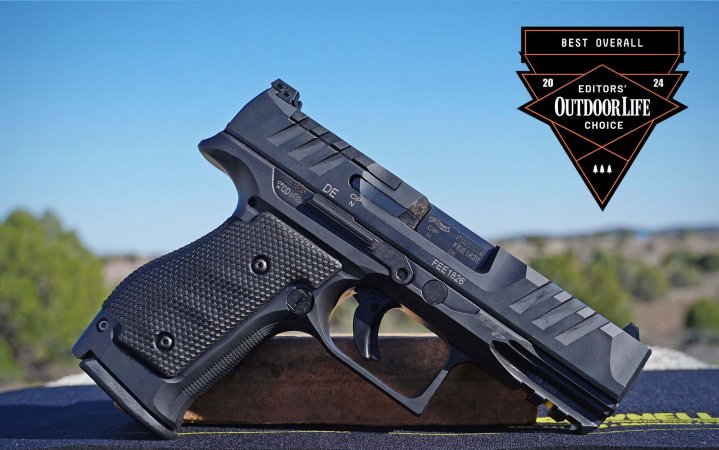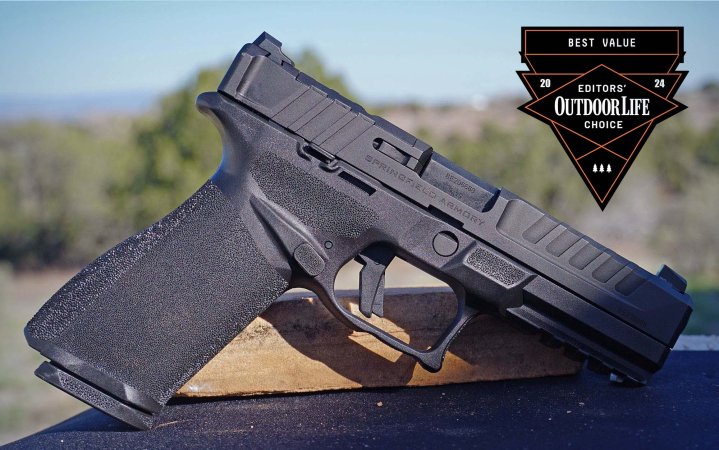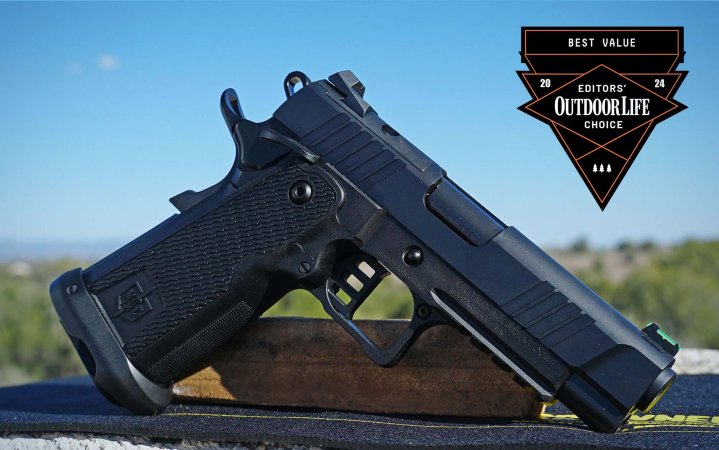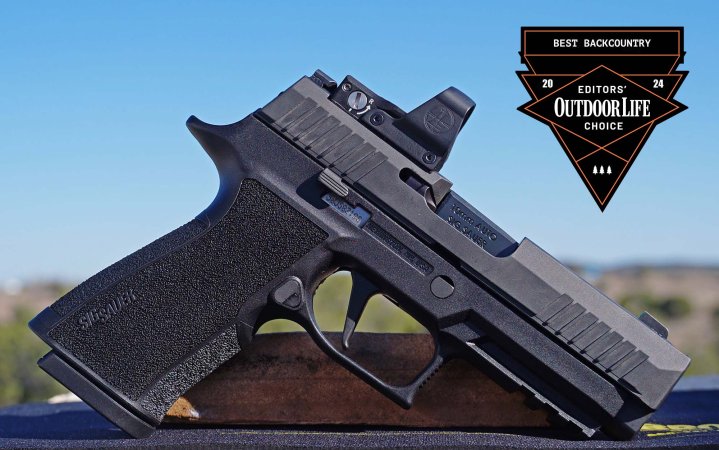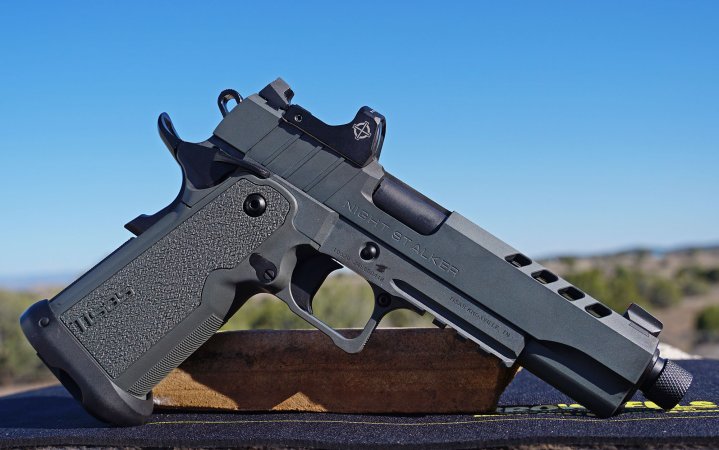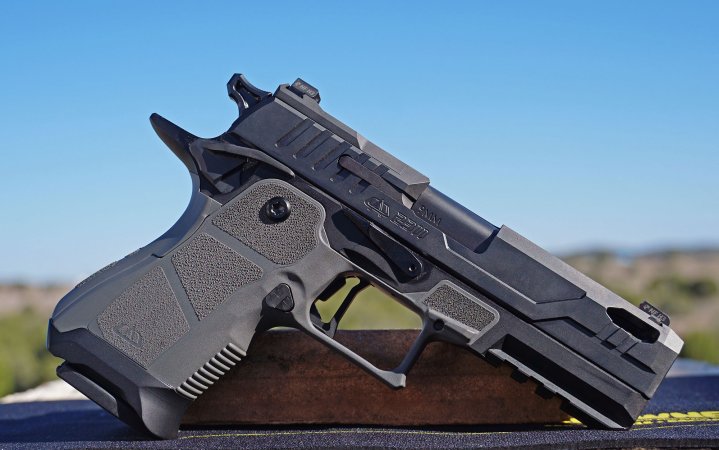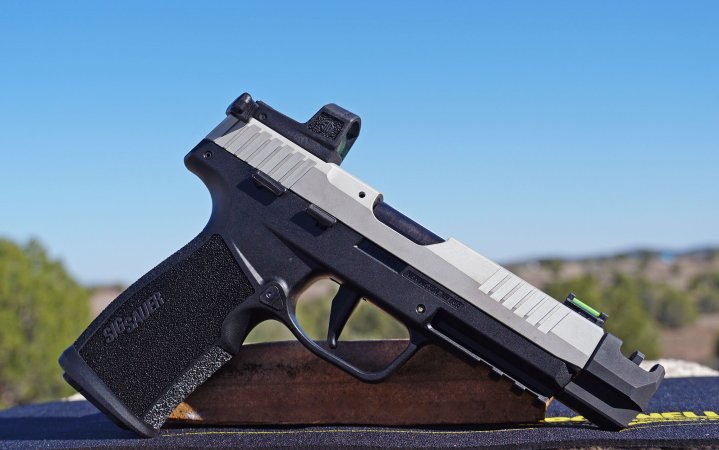We may earn revenue from the products available on this page and participate in affiliate programs. Learn More ›
Outdoor Life’s annual gun test is unrivaled among our peer group in the industry, and testing the best handguns is a huge part of that. For this evaluation, we gather all the new handguns that we can get, shoot them for accuracy, then run the living piss out of them. With that, we get to see which guns rise to the top, and we are nearly always surprised by some guns — for better and worse.
As we’ve done the last couple years, our test team dug in and pitched camp at Gunsite Academy in Paulden, Arizona. Not only is Gunsite rich in firearms testing and instruction history, it’s the perfect venue for us to compare and evaluate the field of new guns. This year we spent several days testing the best rifles and best rimfires, but our work was far from over when we hit the range and steel pits with the best handguns of 2024.
- Editor’s Choice: Walther PDP Compact Steel Frame 4-inch
- Great Buy: Springfield Armory Echelon
- Great Buy: Military Armament Corporation MAC 9 DS
- Best Backcountry Handgun: Sig Sauer P320 XTen Comp
- TISAS 1911 Night Stalker Double Stack 9mm SF
- Hammerli Forge H1 1911 .22 LR
- Beretta 92XI Squalo
- OA Defense OA 2311 Compact Pro
- Sig Sauer P322 Comp
- Glock G29 Gen 5
- Beretta PX4 Storm Compact Carry 2
How We Tested the Best Handguns

Photo by Alex Robinson
Our gun test is unique in that it’s panel tested and judged and, unlike some other industry awards, we have no idea which will come out on top. Whether a company advertises with us or not, everything is judged on a level playing field — something that has probably cost us much more gun advertising dollars than it’s earned.
We begin by equipping pistols with compatible red dot sights and having test team members shoot each handgun for accuracy data. We record five-shot groups at 15 yards, firing from a standing position, with the pistol supported on a bagged tripod. Because this handgun accuracy is more of a comparative tool than our precise rifle accuracy results — and to reduce wear and tear on shooters — we select one generally accurate load for each pistol caliber and record numerous groups.
A low-key, but significant part of our testing process involves field-stripping, cleaning/lubricating, and mounting or swapping optics. This part of the process is made much more effective and efficient with the proper tools. Brownells is one of the best places to get gun-specific tools, and here are a few of the things we used:
Accuracy Test Ammo Used
| Caliber | Brand/Load | Bullet Weight |
| .22 LR | Remington Target | 40 grains |
| 9mm | Staccato Match | 125 grains |
| 10mm | Federal Premium Bonded | 180 grains |
What really matters with handguns is how well they function and how easy they are to shoot accurately in dynamic situations. For this, we spend hours firing the pistols from various positions on steel, executing reloads, running drills, and even doing some holster work. By the time we are picking up brass, each shooter on the test team is intimately familiar with every gun in the test.
How We Grade Handguns

Photo by Alex Robinson
Each test team member grades the handguns in nine different categories and records additional notes about each firearm on their scorecards. The accuracy scores are attained from the cumulative averages of the accuracy data generated by the team, but everything else is up to each tester. We grade on handling, accuracy, workmanship, aesthetics, ergonomics, meets purpose, versatility, reliability, and value, using a 1- to 5 grading system.
The final report card for each firearm averages and consolidates scores into three categories: Performance (handling, accuracy, ergonomics, and reliability), Design (workmanship, aesthetics, meets purpose, and versatility), and Value, which stands on its own.
Here is how our 1-to-5 numerical grading works:
- 4.5+ = Excellent
- 3.5 to 4.5 = Very Good
- 2.5 to 3.5 = Good
- 1.5 to 2.5 = Fair
- Less than 1.5 = Poor
To receive an “Excellent” grade, a gun must really impress us, and present best-in-class traits. It’s not a grade we throw around lightly. Poor, on the other end of the spectrum, is a grade for something we find unacceptable.
Picking The Winners
You’ll notice that our published report card grades don’t always translate to which guns win. That’s because the grades are not granular enough. To pick our overall winners, we rank guns based upon the cumulative number of test team points awarded. For our Great Buy award, we examine the value scores, but also how the gun’s other scores compare to similarly-priced guns. The Great Buy winners are those guns that offer the best bang for the buck, plain and simple.
A Diverse 2024 Field

Photo by Alex Robinson
Despite our post-SHOT-show impressions, we are almost always surprised by the field of guns when we take roll call for the test. After the previous two years, the 2024 field of handguns felt a bit small and disjointed. In the past we’ve seen themes that seem to carry throughout the field, such as micro-compact 9mm pistols, but this year was different. Our field of 11 handguns represented a wide range of categories, designs, and values. We’ve developed a reliable intuition for what the winner’s circle will look like in each test, but none of us really knew how this year’s field would shake out until the brass settled and scores were tallied.
Best Handguns: Reviews and Recommendations
Editor’s Choice: Walther PDP Compact Steel Frame 4-inch
Report Card
- Performance: Very Good
- Design: Very Good
- Value: Good
- Average 5-shot group size at 15 yards: 1.830 inches (9 groups with iron sights)
Accuracy Note: Accuracy figures were recorded using the pistol’s iron sights, and it performed quite well. The pistol is optic-compatible, but we did not have an adapter plate. Accuracy usually improves when adding a red dot optic, but this pistol hung right in with several that were optic equipped.
Walther PDP Compact Steel Frame 4-inch Specs
- Cartridge: 9mm
- Capacity: 15+1
- Action: Semi-auto, single-action, striker-fired
- Barrel length: 4 inches
- Frame material: Steel
- Optic compatibility: Uses optic-specific adapter plates.
- Trigger: Single-action 5 pounds, 1 ounce (measured)
- Weight: 2 pounds, 7 ounces (weighed with empty magazine)
- Price: $1,699
The Walther PDP Compact Steel Frame pistol was one that took our test team a bit by surprise. There aren’t any particularly eye-catching features on this pistol and despite its good ergonomics, it does feel a bit chunky for a compact gun. Add to that the weight of the steel frame and initial test team impressions were somewhat skeptical. Those misgivings melted away as soon as the shooting started, though.
This PDP is one of the latest in Walther’s successful striker-fired lineup that includes the polymer-framed PDP-F series and the full-sized PDP Match SF — both of which I have shot extensively in the past year. This new steel frame compact model aims to capture the tangible recoil-mitigating characteristics of the match gun, but in a carry-friendly package. Though heavy and thick it is, the pistol sports wrap-around grip panels with excellent hexagonal texturing and superb ergonomics for large-handed shooters.
This compact pistol carries over many of the features we already like about the PDP including the long ambidextrous slide stop levers that are easy to reach with the thumb, a reversible magazine catch button, and nicely-executed scalloping and serrations on the slide. It’s got a 3-slot accessory rail machined into the dust cover, and is compatible with a variety of optics using Walther’s adapter plates.

Photo by Austin Rowe
During testing, we were missing an optic adapter plate, so we fired the pistol using its adjustable white 3-dot iron sights. Even with a slight handicap, the pistol was quite accurate, and really began to shine when we started running drills and shooting steel. The single-action trigger is good for a striker-fired gun, and nearly every test team member gravitated towards the PDP.
We feel that this compact model is still too bulky and heavy to have mass IWB carry appeal, but is an excellent option for off-body carry. The extra weight of the steel frame makes this one of the smoothest-shooting striker-fired pistols we’ve tested, and the test team scores reflected that.
Great Buy: Springfield Armory Echelon
Report Card
- Performance: Very Good
- Design: Very Good
- Value: Excellent
- Average 5-shot group size at 15 yards: 1.675 inches (9 groups with red dot optic)
Springfield Echelon Specs
- Cartridge: 9mm
- Capacity: 17+1, 20+1
- Action: Semi-auto, single-action, striker-fired
- Barrel length: 4.5 inches
- Frame material: Steel (with polymer grip module)
- Optic compatibility: Removable pillars to accommodate multiple optic footprints
- Trigger: Single-action 5 pounds, 7 ounces (measured)
- Weight: 1 pound, 13 ounces (weighed with empty magazine)
- Price: $650
Introduced mid-2023, the Echelon is a significant departure from Springfield’s other striker-fired pistols like the XD and Hellcat series. Most notably, it adopts a removable fire control group chassis system similar to those of the P320 and P365 from Sig. This sets the platform up for modularity and potential upgrades, aiding Springfield’s aim to offer a better duty-grade pistol.
The Echelon is a full-size gun that comes with 17- and 20-rounds magazines, and has a nicely contoured and textured polymer grip module. It’s got a beneficial undercut-profile trigger guard and aggressive cocking tabs and serrations on the front and rear of the slide. The dust cover on the grip module has a 4-slot accessory rail to house a wide variety of tactical lights, and both the pivoting takedown lever and support-hand thumb pads are given a grippy texture.
One of the most thoughtful features of the Echelon is its optic-mounting system. The pistol comes with a cover plate, but doesn’t use optic adapter plates. Instead, it employs a set of removable pins that can be configured in the slide cut to fit a variety of optic footprints — giving the user a lower, easier-acquiring optic placement.
Downsides of the Echelon are its small and somewhat sharp slide stop levers, and I’d like to see them use a stainless or tungsten guide rod rather than polymer – though Apex tactical already makes a nice aftermarket guide rod for it. All in all, The Echelon is a well-executed, feature-rich pistol that scored neck-and-neck with the more expensive Walther. It represents a screaming value at $650 — roughly the price of a standard Glock — and unquestionably deserves a Great Buy award. You can read a full in-depth review here.
Great Buy: Military Armament Corporation MAC 9 DS
Report Card
- Performance: Very Good
- Design: Very Good
- Value: Excellent
- Average 5-shot group size at 15 yards: 1.830 inches (9 groups with iron sights)
Accuracy Note: The MAC 9 DS we had at the gun test was shot with iron sights. The optic cover plate was stuck in place and we did not have the tools in the field to remove it. I have tested another MAC 9 DS pistol with a red dot optic and the same Staccato Match ammo and recorded an average group size of 1.242 inches (5 groups).
Military Armament Corporation MAC 9 DS Specs
- Cartridge: 9mm
- Capacity: 17+1
- Action: Semi-auto, single-action, hammer fired
- Barrel length: 4.25 inches
- Frame material: Steel
- Optic compatibility: Holosun 507K and RMSc footprint
- Trigger: Single-action, flat shoe, 3 pounds, 4 ounces (measured)
- Weight: 2 pounds, 5 ounces (weighed with empty magazine)
- Price: $1,040
When we pick a Great Buy award winner, we don’t simply choose the cheapest gun that bothered to show up — it has to represent a legitimately impressive value in its category. That’s exactly what we got with the MAC 9 DS 1911 9mm. This pistol, following in the footsteps of the Springfield Prodigy, is a budget-priced 2011-style pistol that mimics the design of guns like the popular Staccato P. Though Turkish-imported guns often garner fair criticism, MAC (which is under SDS Imports) has hit a home run with this one.
The MAC 9 DS adheres the same basic formula as most 2011-style pistols: It’s a 1911 design with a frame that terminates at the top of the grip. Unlike regular 1911s that incorporate the handle or grip into the frame, 2011-style guns use a removable grip module that includes the trigger guard. The MAC 9 DS uses 17-round TISAS 2011-style magazines that are copies of (and interchangeable with) the Staccato 2011 and Duramag steel magazines.
Though it closely resembles the Staccato P (which costs about $1,500 more), the MAC 9 DS uses a more primitive guide rod and recoil spring assembly, and isn’t as refined. Still, our test team loved this pistol and we recorded no malfunctions or significant complaints. It’s got a good trigger and the bushingless bull barrel is quite accurate. I reviewed the MAC 9 DS earlier, testing with an optic, but I was unable to remove the optic cover plate from our test sample on the range at Gunsite — so we ran it with the iron sights which consist of a black serrated rear notch and fiber-optic front.
For just over a thousand bucks, you’re not getting a Staccato, but the MAC 9 DS is a tremendous value for that price. It performs well, is simple and smartly executed, and makes an awesome entry-level gun for anyone looking to dabble with the 2011-style platform. An improved recoil system or trigger job would be an easy pull if you want to tinker or upgrade.
Best Backcountry Handgun: Sig Sauer P320 XTen Comp
Report Card
- Performance: Very Good
- Design: Good
- Value: Excellent
- Average 5-shot group size at 15 yards: 1.801 inches (9 groups with red dot optic)
Sig Sauer P320 XTen Comp Specs
- Cartridge: 10mm
- Capacity: 15+1
- Action: Semi-auto, single-action, striker-fired
- Barrel length: 3.8 inches
- Frame material: Stainless steel
- Optic compatibility: Delta Point footprint
- Trigger: Single-action, flat shoe, 5 pounds, 9 ounces (measured)
- Weight: 2 pounds, 0 ounces (weighed with empty magazine)
- Price: $950
The 10mm has enjoyed a wave of popularity in recent years, primarily as a more shootable alternative to large-bore wheelgun cartridges that Fudd lore has told us are necessary for effective bear protection. Many have recognized the value of the 10mm in the role of wilderness defense and we’ve seen multiple new guns each year. The Sig Sauer P320 XTen Comp is what we believe to be the best, most shooter-friendly platform for the 10mm that also functions well in a backcountry carry capacity. Why? It has great ergonomics and is flat-out easier to shoot well and manage recoil than with any other 10mm we have tested.
The P320 XTen comp (you can read a full review here) is a second, more optimized iteration of their first P320 10mm, the Xten. The characterizing feature of the XTen Comp is, of course, the integrated muzzle compensator. Often, compensators built into the slides of guns are lackluster in their recoil reduction, but the one on this pistol is nicely dished out and offers significant recoil and muzzle flip reduction. This allowed us to snap back on target more quickly than we could with other 10mms like the Glock G20 Gen 5 or FN 510.

Photo by Alex Robinson
Aside from the recoil reduction, benefits are found in the relatively slender grip profile and stellar ergonomics. The grip dimensions of the P320 XTen are virtually identical to those of the 9mm P320 models. The pistol uses a similar but longer removable fire control unit and frame to accommodate the longer 10mm cartridge, but it’s compatible with aftermarket triggers like the enhanced trigger from KGM Technologies.
The P320 XTen Comp is also more compact than the original XTen and ubiquitous Glock G20. The shorter 3.8-inch barrel will result in slight velocity drops, but on-average a 3.8-inch barrel only lags behind 4.6- or 5-inch barrels by about 50 to 75 fps. Combine this packable, ergo-friendly, manageable pistol with 10mm ammo like Black Hills HoneyBadger or G9 External Hollowpoint, and you’ve got a winning backcountry combo.
TISAS 1911 Night Stalker Double Stack 9mm SF
Report Card
- Performance: Very Good
- Design: Good
- Value: Excellent
- Average 5-shot group size at 15 yards: 1.833 inches (9 groups with red dot optic)
Walther PDP Compact Steel Frame 4-inch Specs
- Cartridge: 9mm
- Capacity: 17+1
- Action: Semi-auto, single-action, hammer-fired
- Barrel length: 4 inches
- Frame material: Steel with Polymer Grip module
- Optic compatibility: Holoson 507k and RMSC footprint
- Trigger: Single-action 5 pounds, 9 ounces (measured)
- Weight: 2 pounds, 6 ounces (weighed with empty magazine)
- Price: $900
Another surprising entry to this year’s test was the TISAS 1911 Night Stalker DS 9mm, which is another Turkish 2011-style pistol from SDS imports. Even after being impressed by the MAC 9 DS, I had my reservations about the Night Stalker. Some Turkish pistols have a gaudy feature set tacked onto a so-so foundation — the classic example of putting lipstick on a pig — but fortunately that wasn’t the case here. Like the MAC 9, this pistol ran well and it brings a lot to the table for that price. In fact, this was tightly in the running for a Great Buy award, but the MAC 9 edged it out by a few overall performance points. Rest assured, its value did not go unnoticed by us.
The TISAS Night Stalker is similar to the MAC 9 and other 2011-style pistols in many ways, but it’s about $200 cheaper and sports a threaded muzzle and gray Cerakote finish on both the slide and frame. It has modest cocking serrations at the rear and mostly aesthetic slide porting up front. Overall, we couldn’t find anything wrong with the Night Stalker — it had a pretty good trigger and smooth operation — but everything was a bit less refined than on the MAC 9 DS.

Photo by Alex Robinson
The threaded barrel on the Night Stalker is thinner than the bull barrel on the MAC 9 DS and doesn’t offer the same level of accuracy, but it more than compensates with fun when a suppressor is attached. I configured my Silencerco Omega 36M for pistols and we burned hundreds of rounds pinging away at steel.
For under $1,000, this is an excellent value for this style of pistol, but you may eventually want to upgrade.
Hammerli Forge H1 1911 .22 LR
Report Card
- Performance: Good
- Design: Good
- Value: Very Good
- Average 5-shot group size at 15 yards: 1.962 inches (10 groups with iron sights)
Hammerli Forge H1 1911 .22 LR Specs
- Cartridge: .22 LR
- Capacity: 12+1
- Action: Semi-auto, single-action, hammer fired
- Barrel length: 5 inches
- Frame material: Aluminum
- Optic compatibility: Not optic compatible
- Trigger: Single-action, curved shoe, 7 pounds, 3 ounces (measured)
- Weight: 2 pounds, 1 ounce (weighed with empty magazine)
- Price: $334
No sane shooter can deny enjoying a .22 LR pistol, especially one that feels like a full-size 1911 .45. This year, Hammerli Arms — under Walther — has released the Force H1 1911/22, manufactured by Umarex in Germany. I have touted their amazing full-auto BB guns, and it turns out that they make a great .22 pistol as well.
The Forge H1 is similar to previous full-size 1911-22 designs fielded under Colt’s brand, and features a fixed barrel that is flush with the slide at the muzzle, but can be fitted with a suppressor adapter. It’s fed from a single-stack magazine that holds 12 rounds, and the gun is externally the same dimensions as a full-sized 1911 chambered in .45 ACP. It’s weighted robustly and fits in many 1911 holsters, making it a great training tool or plinker.
Everyone on the test team had fun with this gun and it ran without a hitch. I had an early production model that seemed to have a recoil spring issue and wouldn’t run with a full magazine — but our gun test sample was a peach. The pistol was quite accurate, and the only problem we had was that we couldn’t reload magazines fast enough.
Beretta 92XI Squalo
Report Card
- Performance: Very Good
- Design: Good
- Value: Good
- Average 5-shot group size at 15 yards: 1.262 inches (9 groups with a red dot optic)
Beretta 92XI Squalo Specs
- Cartridge: 9mm
- Capacity: 22+1
- Action: Semi-auto, single action, hammer-fired
- Barrel length: 4.7 inches
- Frame material: Steel
- Optic compatibility: Uses optic-specific adapter plates.
- Trigger: Single-action 5 pounds, 5 ounces (measured)
- Weight: 2 pounds, 3 ounces (weighed with empty magazine)
- Price: $1,329
The new Beretta 92XI Squalo isn’t your pappy’s Desert Storm M9 — it’s a slicked up race gun that any Beretta 92 fan will fall in love with. I can’t say that I was ever fond of the Model 92, but this new iteration wipes out my main gripe, which was the double/single-action trigger. The 92 XI is single-action-only, and has a nicely profiled match trigger that breaks crisply and resets nicely.
Other major updates to the platform include the grip. The backstrap has been almost totally straightened, and the front is gently contoured with nice checkering in the steel frame. The straight backstrap allows you to really choke up on the pistol with a high grip and provides a short trigger reach. An optic-mounting system is also incorporated, where a plate is installed atop the slide.
We found the 92XI Squalo to be quite accurate and a smooth shooter. Its 22-round magazines are great for competition, and the recoil impulse is light, allowing quick follow-up shots. We did feel that the optic plate put the glass too high above the bore axis for fast acquisition though, and a shooter would probably do well to stick with irons or a low-profile red dot.
OA Defense OA 2311 Compact Pro
Report Card
- Performance: Good
- Design: Very Good
- Value: Good
- Average 5-shot group size at 15 yards: 1.816 inches (12 groups with red dot sight)
OA Defense OA 2311 Compact Pro Specs
- Cartridge: 9mm
- Capacity: 15+1
- Action: Semi-auto, single-action, hammer-fired
- Barrel length: 4.25 inches
- Frame material: 7075 Aluminum
- Optic compatibility: Includes optic-specific adapter plates.
- Trigger: Single-action, flat shoe, 4 pounds, 8 ounces (measured)
- Weight: 1 pound, 12 ounces (weighed with empty magazine and no optic)
- Price: $2,349

This premium-grade pistol has taken the 2011 trend in a unique direction. Many of the basic elements of a 2011-style pistol are there, like a short frame with grip module and a 1911-style trigger and hammer, but it’s built to use Sig Sauer P320-pattern magazines — which are more numerous, affordable, and tend to be less finicky than actual 2011-style magazines. This selling point got the company a lot of attention since their debut in 2023, and I was very excited to shoot their new Compact Pro model after taking it for a spin at SHOT Show 2024.
The OA 2311 Compact Pro has a profile similar to a Glock G19, but uses an aluminum frame and polymer grip module that’s capped with a magwell. The grip module is intended to be user-modified or stippled, and features gas-pedal-type thumb rests on both sides, as well as ambidextrous controls and a reversible mag catch button. We got the ported model, which has ports drilled through the slide and barrel to help reduce muzzle flip — and it works wonderfully at that. This is one of the flattest-shooting 9mm compacts that I’ve ever fired. As a package, it comes with five magazines, a nice carrying case, and a number of optic plates. I installed a Holosun EPS Carry for my full-length review, but we also tested it with iron sights at the gun test.

Photo by Austin Rowe
Some testers weren’t hot on the pistol’s ergonomics, and the grip didn’t fit my hand perfectly. The only real demerit though, was the rough break-in period the gun had. It took approximately 300 rounds for the pistol to run most types of ammo smoothly, and it was still a little picky. I noticed some excessive wear on the inner surfaces of the slide and behind the disconnector — that binding and friction will slow a gun down just enough to cause problems. It wasn’t a deal breaker for the test, but something we took note of.
Sig Sauer P322 Comp
Report Card
- Performance: Good
- Design: Good
- Value: Good
- Average 5-shot group size at 15 yards: 1.264 inches (9 groups with red dot optic)
Sig Sauer P322 Comp Specs
- Cartridge: .22 LR
- Capacity: 20+1, 25+1
- Action: Semi-auto, single-action, internal hammer fired
- Barrel length: 4 inches
- Frame material: Stainless steel, polymer grip module
- Optic compatibility: Includes Sig Romeo Zero Elite red dot
- Trigger: Single-action, curved and flat shoes included, 4 pounds, 6 ounces (measured)
- Weight: 1 pound, 4 ounces (weighed with empty magazine)
- Price: $680
This .22 LR race gun is a provocative mix of fun and flashy features. It’s based on Sig’s successful P322 platform that mimics the size and feel of the P365 XMacro in 9mm, but packed with the features of an open-class race blaster. It’s got a clear anodized aluminum slide that houses a steel bolt insert, and operates on a fixed barrel housed in its black polymer grip module. Unlike the centerfire models, the P322 is fired by an internal hammer, not a striker.
The highlights of the P322 comp are, of course, its race-gun features. It sports a two-port muzzle compensator up front, a GoGun-style gas pedal takedown lever, cocking tabs at the rear of the slide, and is topped with a Sig Romeo Zero Elite red dot sight. They give the gun some hot-rod appeal, even if their effectiveness with the little .22 LR cartridge is probably nominal.
This pistol has many sterling qualities, but also some drawbacks. One of our favorite things is a double-stack magazine — which are shockingly scarce in .22 pistols in the year 2024. The 20- and 25-round magazines function very well and should be standard with every .22 pistol. On the other side, some of the test team didn’t think that the P322 Comp felt like a “real gun,” and it certainly doesn’t have the mass or character of a Mark IV that you can pass along to your grandkids. Also, the pistol ran reliably for us, but within a few hundred rounds, the barrel leaded up so badly that bullets were key-holing at 15 yards — an issue I experienced with the regular P322 and some ammo. Scrubbing the bore relieves the problem, but it’s something to keep in mind.
Glock G29 Gen 5
Report Card
- Performance: Good
- Design: Good
- Value: Good
- Average 5-shot group size at 15 yards: 2.381 inches (9 groups with iron sights)
Glock G29 Gen 5 Specs
- Cartridge: 10mm
- Capacity: 10+1
- Action: Semi-auto, single-action, striker-fired
- Barrel length: 3.78 inches
- Frame material: Polymer
- Optic compatibility: Not optic compatible
- Trigger: Single-action 7 pounds, (measured)
- Weight: 1 pound, 11 ounces (weighed with empty magazine)
- MSRP: $550
The world of Glocks is consistent and reliable, even if that means no big surprises. The folks in Austria are continuously chugging away, adding slight improvements to a recipe that works, and this year we saw a Gen 5 update to the compact 10mm G29. Notable improvements include updates to the barrel, removal of the finger grooves, and the addition of front slide serrations for us front-cockers. Those last two give the G29 a bit more purchase for both cocking the gun and hanging on during the brutal recoil cycle — the finger grooves sometimes inhibited a good, proper grip more than they facilitated it. With this little package in 10mm, you will certainly need a good grip. There’s no room for your pinkie on this one.
To say that this gun wasn’t the test team’s favorite plinker would surprise no one, but we were able to get surprisingly good accuracy out of it with iron sights. A notable point is the lack of M.O.S. optic compatibility — there’s no optic cut on the G29 Gen 5.
The G29 is the O.G. compact 10mm, but it will always be a niche gun — especially with the plethora of more manageable 9mm micro compacts. Still, the G29 can be (and has been) employed as an effective bear defense gun and if you’re willing to practice and take the appendage abuse, it’s a solid pick.
Beretta PX4 Storm Compact Carry 2
Report Card
- Performance: Good
- Design: Fair
- Value: Fair
- Average 5-shot group size at 15 yards: 2.509 inches (9 groups with iron sights)
Beretta PX4 Storm Compact Carry 2
- Cartridge: 9mm
- Capacity: 15+1
- Action: Semi-auto, double/single-action, hammer-fired
- Barrel length: 3.2 inches
- Frame material: Polymer
- Optic compatibility: Not optic compatible
- Trigger: Double/single-action 7 pounds, 9 ounces (measured)
- Weight: 1 pound, 11 ounces (weighed with empty magazine)
- MSRP: $802
Beretta’s PX4 Storm has been a popular carry gun, and the new PX4 Storm Concealed Carry 2 is further optimized for that task. Like the regular PX4, it features a rotating barrel design, but the CC2 version has a heavier barrel that adds mass and mitigates recoil. Notably, it also has an improved de-cocker and bobbed, snag-free hammer and improved double-action trigger pull.

Photo by Alex Robinson
The whole test team found the PX4 to be a soft, manageable shooter, and some really liked it. We had mixed feelings though. Some of us plainly thought it would be smaller than it is, and it certainly does have a thick, chunky feel to it. That thickness does help the shooter get more purchase on the gun, but considering the abundant number of manageable pistols that are more compact with equal or greater capacity, we had a hard time falling in love with this one.
Though the double-action trigger pull isn’t bad, the decocker and double-action function simply isn’t something that shooters want to see on a concealed carry pistol in 2024.
Final Thoughts on the Best Handguns of 2024

Photo by Scott Einsmann
Though we were initially underwhelmed by the size of the handgun field — because we’ve tackled such large numbers of entries the past two years — we were impressed and surprised with the quality of this year’s handguns. We have to be honest about what we like and what we don’t, but we didn’t need to scratch a single gun from the test this year, and every pistol had its charms.
Most excitingly, none of us could predict the results of such a mix of good handguns. The field was packed with surprising performers, excellent values, and market-driving ingenuity. I hope that these themes continue for many years to come.
About Gunsite Academy

This year’s test of the best handguns was once again graciously hosted by Gunsite Academy in Paulden, Arizona. As the home of the legendary Jeff Cooper and one of the first firearm training facilities that offered classes to the general public, Gunsite is one of the premier gun training destinations in the country.
At Gunsite we work with their top-line instructors and use their excellent ranges and facilities. The genuinely friendly, helpful, and overly-accommodating staff at Gunsite allowed us to conduct our most ambitious gun test to date. You can experience the magic of Gunsite, and improve your skills, by signing up for a class.

